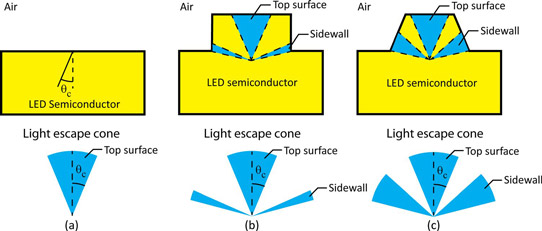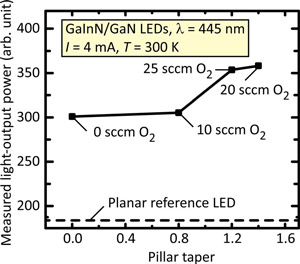- News
22 October 2012
Tuning micro-pillars to increase light extraction from nitride LEDs
Rensselaer Polytechnic Institute (RPI) and Samsung Electronics have used tapered micro-pillars of titanium dioxide (TiO2) to increase light extraction from nitride semiconductor light-emitting diodes (LEDs) by up to 100% [Ming Ma et al, Appl. Phys. Lett., vol101, p141105, 2012].
Light extraction is a problem in nitride LEDs because there is a large difference in refractive index between gallium nitride (GaN, refractive index ~2.5) surfaces and air (refractive index 1). This difference restricts the escape cone for light to just 24° (Figure 1a).

Figure 1: Schematic diagrams of light extraction from (a) rectangular-parallelepiped-shaped LED with no surface features, (b) rectangular-parallelepiped-shaped LED with a micro-pillar with vertical sidewalls, and (c) rectangular-parallelepiped-shaped LED with a micro-pillar with tapered sidewalls.
The light extraction can be enhanced through surface texturing with micro-pillars. With vertical sidewalls these pillars can give a certain amount of enhancement (Figure 1b), but even better performance could be achieved with a tuned tapering (Figure 1c).
Surface texturing of GaN is limited by the crystal structure to certain angles of taper and shapes (e.g. pyramids with angles around 58°).
The RPI/Samsung approach is to use a layer of TiO2 for which the taper angle can be changed through different etch conditions. This material was chosen because it was matched in refractive index to GaN at the target wavelength of 445nm.
A 500nm TiO2 film was sputtered onto the ‘n-type’ side of 445nm-wavelength gallium indium nitride (GaInN) LED epitaxial material. In fact, the researchers left some undoped GaN above the n-GaN contact layer to protect the active region during subsequent etch processes.
A photomask was applied, followed by inductively coupled plasma reactive-ion etch (ICP-RIE) to create pillars in the TiO2. Tri-fluoro-methane (CHF3) was used for anisotropic etch, along with O2 for isotropic etch. The mix of gases allows control of the taper angle.
The range of taper angles that were possible included the optimum suggested in previous ray-tracing simulations carried out by the researchers. The pillars were 4-5µm in diameter, around 3µm high, and separated by about 1µm.
The material was processed into 1mm x 1mm square LEDs. The chips were flipped so that the n-type side was the one through which light was emitted. Therefore, no metal electrodes were deposited on that side to avoid blocking light output.
The light from devices with vertical micro-pillars showed a 68% increase in output power over planar LEDs produced for comparison purposes (Figure 2). The largest enhancement of 100% was seen for tapered micro-pillar LEDs with parameter 1.4 (35-36° angle to GaN surface plane), close to the value found in the ray-tracing simulations. The taper parameter for vertical micro-pillars was 0 (90°).
 Figure 2: Measured light-output power as a function of the pillar taper for GaInN LED patterned with array of TiO2 micro-pillars. For comparison, planar reference LED performance is also shown.
Figure 2: Measured light-output power as a function of the pillar taper for GaInN LED patterned with array of TiO2 micro-pillars. For comparison, planar reference LED performance is also shown.
The addition of micro-pillars was found not to impact current-voltage behavior of the LED, and thus the production process did not adversely impact power consumption performance. The angular spread of the emission was wider for the devices with micro-pillars and actually dipped for the direction normal to the plane of the LED.
A range of organizations funded the research: Samsung LED, the Korean Ministry of Knowledge Economy and the Korea Institute for Advancement of Technology through International Collaborative R&D Program, the US National Science Foundation (NSF), Sandia National Laboratories, the US Department of Energy, Magnolia Optical Technologies, and Raydex Technology Inc.
http://link.aip.org/link/doi/10.1063/1.4756797
The author Mike Cooke is a freelance technology journalist who has worked in the semiconductor and advanced technology sectors since 1997.


